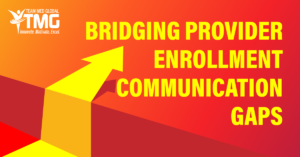
The Payer Communication Maze: Why Getting Straight Answers Feels Impossible
For Provider Lifecycle Professionals (PLPs) working in provider enrollment, getting a provider into a health plan should be straightforward. You submit a complete, accurate application, the payer reviews it, and—if all requirements are met—the provider is approved and ready to see patients.
In reality, it’s rarely that smooth.
Instead, the process is often marked by miscommunication, conflicting information, and a lack of clear accountability. And the PLP, tasked with keeping the process moving, is left to navigate a maze that feels designed to slow them down.
The Communication Problem in Action
Here’s a common scenario: You call a payer’s contracting line to resolve an issue that’s holding up an enrollment. Usually, the call goes to voicemail and you rarely receive a return call. If you are fortunate to have someone answer the phone, you may be directed one way and when you call back with an additional question, you’re told the exact opposite of what the last representative said.
To make matters worse:
- Some plans explicitly instruct you not to call for 30 days after submitting an application, even when there’s a legitimate question or urgent issue.
- Rules seem to shift from one interaction to the next, as if the health plan is inventing its own process apart from state or federal guidance.
- Representatives rarely have ownership of a file, meaning no single person is accountable for ensuring progress.
- Specialists are sometimes treated dismissively, as though seeking clarity is an inconvenience rather than a necessary part of doing the work correctly.
Why It’s So Difficult to Get Straight Answers
The root causes go beyond individual representatives:
- Departmental silos – Contracting, credentialing, enrollment, and customer service are often separate functions with minimal cross-communication.
- No legislated turnaround times – Without regulations requiring prompt responses, there’s no external pressure on payers to address issues quickly.
- Cost containment focus – Delays, intentional or not, can defer payments to providers—and that benefits the payer’s bottom line.
- High turnover in payer staff – Representatives change frequently, and training isn’t always consistent.
This means even well-prepared PLPs face unpredictable delays, and those delays can affect revenue cycles, provider start dates, and patient access to care.
Workarounds
Faced with these challenges, many provider enrollment specialists develop their own survival strategies. One of the most common? Maintaining custom spreadsheets that track each plan’s contacts, preferred submission methods, idiosyncratic requirements, and unofficial “real” timelines.
These resources can be invaluable internally, but they also point to the larger problem: PLPs are doing extra work to compensate for systemic inefficiencies they don’t control.
What PLPs Can Do Now
Until state or federal regulations set clear response timelines and enforce accountability, PLPs will need to rely on process discipline, documentation, and peer networks to keep work moving. Practical steps include:
- Build a payer reference guide – Capture contact names, departments, and current requirements. Update it after every call.
- Document every interaction – Include date, time, representative’s name, and a summary of the conversation. Ask for confirmation numbers whenever possible. Get to know them on LinkedIn. Develop that relationship!
- Batch your follow-ups – Time them to match each payer’s stated review cycles unless urgent issues demand immediate escalation.
- Know the escalation path – Identify supervisor contacts or formal grievance procedures early.
- Share intel with peers – Networking with other PLPs can uncover changes before they’re officially communicated.
The Bigger Picture
Provider enrollment isn’t just a paperwork process; it’s a gatekeeper function that directly affects whether providers can deliver care and get paid for it. Every delay ripples outward: a provider’s start date moves back, patient access shrinks, and organizational revenue takes a hit.
Until there’s real accountability built into the system, PLPs will remain the ones holding the process together. By documenting relentlessly, sharing knowledge, and building flexible workflows, we can close the gaps where we can and be ready to push for systemic change where we can’t.

